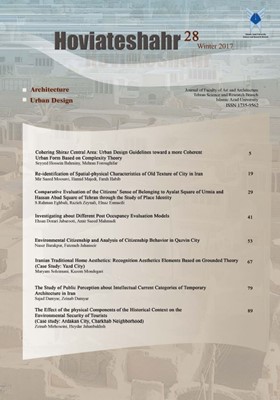Investigating about Different Post Occupancy Evaluation Models
Subject Areas : architectureEhsan Dorari Jabarooti 1 , Amir saeed Mahmoodi 2
1 - Ph.D. Candidate, Science and Research Branch, Islamic Azad Univercity, Tehran,Iran
2 - Associate Professor, Tehran Univercity, Tehran,iran
Keywords:
Abstract :
One of the most critical aspects of controlling the quality of a design project, is believed to be the “Evaluation” stage. Architects’ responsibilities are not well defined and reinforced in the design process of a project in our country. On the contrary, in the US, the American Institute of Architects contract defines “Post Design Evaluation” as the sixth step of the architect’s responsibilities in a design process. In that country, General Services Administration (GSA) uses Post Occupancy Evaluations (POEs) to assess how building projects perform. The evaluations take a close look at the end-user satisfaction, sustainability, operational effectiveness, and compliance with GSA’s design standards. In contrast to GSA’s building Commissioning Program, which evaluates building performance from project planning through tenant occupancy, a POE evaluates how a building performs six months to two years after occupancy. It provides an overview of how a building functions in operation. During this evaluation five steps recommended as the process steps: a) Determine the appropriate approach; b) Collecting data; c) Analysis; d) Conclusions and data explanation and e) Test the results.GSA’s POE tools and methods are characterized by evaluation of real world performance of occupied buildings:• Physical measurements of indoor environmental quality (acoustics, air quality, lighting, thermal conditions),• Evaluation tools such as space utilization surveys, floor plan analysis, and social network analysis objectively records about the use under occupation space,• “Assessment factors” are assessed conditions by evaluating systems, controls, energy use, and water use, and by interviewing facility managers,• Web-based surveys broadly gauge occupant satisfaction with as-delivered building services and design features.By looking at the massive records of constructing buildings in Iran it is obvious, except for a few percentages, that most buildings do not satisfy their users and inhabitants. Most users complain about the low quality of their projects. Since the users pay a lot of money, they expect to receive a better-quality buildings than what the architects/builders provide. In order to overcome this shortcoming and deficiency in Iran, it is necessary to look at the Post Occupancy Evaluation, and expect the architects to consider that during the design process.Concepts such as “maintenance” and “post occupancy evaluation” seem to be unfamiliar to the field of this profession. As a result, most problems and Difficulties with constructions seem to repeat themselves in most projects.This article makes an attempt to review the importance and necessity of “post occupancy evaluation”. It reviews different methods of evaluation, and it defines the most appropriate evaluation methods during each phase of the design process. Evaluation in architecture is also considered as a method for management control and analysis. Concepts related to evaluation in the field of construction are very broad and they are usually valid during the whole process of design and performance.The results of this article will provide the architects and the constructor managers different Post Occupancy Evaluation models to compare between different evaluation methods within various aspects of “phenomenon”, “process evaluation”, “functional performance” and “technical performance” in a project.... Keywords: Evaluation, Evaluation Methods, Post Occupancy Evaluation, Project Delivery.
اسلامی، سید غلامرضا. (1383). توسعه درونزا و مدیریت هنری. مجموعه مقالات هم اندیشیها. اولین هم اندیشی هنری. آذرماه 1383.(ص29-49). تهران: نشریه فرهنگستان هنر جمهوری اسلامی.
اسلامی، سید غلامرضا؛ و ایروانی، هوتن. (1387). تراکم ساختمانی و توسعه درونزا، نمونه موردی شهر اصفهان. نشریه هویت شهر، 3، 3-12.
اسلامی، سید غلامرضا؛ و جبروتی، احسان. (1392). بهبود کیفی طراحی بر پایه مدیریت بهینه عوامل مؤثر. نشریه مطالعات معماری ایران، 5، 65-82.
ایمان، محمد تقی؛ و غفاری نسب، اسفندیار. (1389). مبانی روششناختی تحقیقات میدانی و چگونگی انجام آن. نشریه پژوهش، 2(2)، 5-30.
بازرگان. عباس. (1391). ارزشیابی آموزشی. (ویرایش دهم). تهران: امیرکبیر.
بازرگان، عباس. (1389). مقدمه ای بر روشهای تحقیق کیفی و آمیخته. تهران: آگاه.
حاجیان، زهره؛ و سرافراز، بهمن. (1392). بررسی رابطه بین مسولیت اجتماعی شرکتها و هزینه حقوق صاحبان سهام در شرکتهای پذیرفته شده در بورس اوراق بهادار تهران. نشریه پژوهشهای حسابداری، 4(2)، 105-123.
خوشفر، غلامرضا؛ بارگاهی، رضا؛ و کرمی، شهاب. (1392). سرمایه اجتماعی و پایداری شهری، مطالعه موردی: شهر گرگان. فصلنامه مطالعات شهری، 8(32)، 31- 46.
دورک، دانا پی. (1392). برنامه دهی معماری. (سید امیر سعید محمودی، مترجم). تهران: دانشگاه تهران. (نشر اثر اصلی)
کاملنیا، حامد؛ اسلامی، سید غلامرضا؛ و حناچی پیروز. (1389). تحلیل و ارزیابی معماری جمعی بر مبنای شاخصههای احساس جمعی. نشریه هویت شهر، 7،131-14.
کریمی، تورج. (1385). رویکرد نوین به ارزیابی عملکرد سازمانها. مجله تدبیر، 171، 22-27.
لاوسون، برایان. (1385). طراحان چگونه میاندیشند. (حمید ندیمی، مترجم). تهران: شهید بهشتی.
محمودی، سید امیرسعید؛ و ناری قمی، مسعود. (1393). «ارزیابی پس از بهره برداری» یک هدف و یک وسیله آموزشی در معماری. نشریه هنرهای زیبا، 19(1)، 71-82.
AIA National. (2007). Integrated Project Delivery: A Guide. California (the American Institut of Architecture). Retrived july 2016, from http://www.info.aia.org/siteobjects/files/ipd_guide_2007.pdf
Becke, A. K., Cudmore, B. A., & Ronald, P. H (2006). The Impact of Perceived Corporate Social Responsibility on Consumer behavior. Journal of Business Research, 1(59), 46-53.
Barlex, M. J. (2006). Guide to Post Occupancy Evaluation. AUDE & West Minxter University & HEFCE (Higher Education Finding Council For England). Retrived july 2016, from http://www.smg.ac.uk/documents/POEBrochureFinal06.pdf.
Fafaliou, I., Lekakou, M., & Theotokas, I. (2005). Is The European Shipping Industry Aware of Corporate Social Responsibility? IDEAS. Retrived july 2016 from https://ideas.repec.org/a/eee/marpol/v30y2006i4p412-419.html
Federal Facilities Council. (2001). Learning from Our Building :A State- of-the Practice Summary of Post-Occupancy Evaluation, Technical Report No 145, National Academic Press, Washington DC. Retrieved June 2016 From http://www.nap.edu/read/10288/chapter/1
Preiser, W. F. E., & Schramm, U. (2005). A conceptual framework for building performance evaluation, chapter 2 in Assessing Building Performance. Editors: W.F.E. Preiser and J. C.Vischer, Elsevier Butterworth-Heinemann, Oxford,UK. Retrived August 2016 from http//www.gci.org.uk/Documents/architecture-ebook-assessing-building-performance_.pdf
Sanoff, D. (2000). Community Participation Methods in Design and planning, Retrved August 2016 from http://www.books.google.com
Turner, J. R. (2004). Corporate Social Responsibility: Should Disclosure of Social Considerations is Mandatory?. Melborn: Monash University. Retrived july 2016. From www.ensani.ir/storage/Files/20140601103259-9919-20.pdf
_||_

